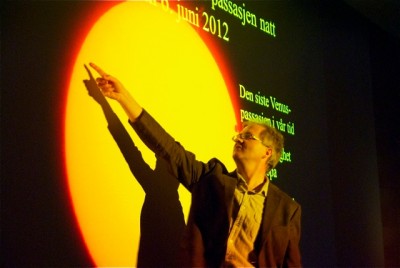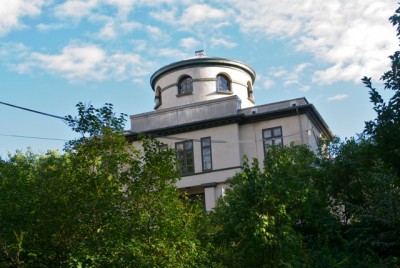As an astrophysicist, Knut Jørgen Røed Ødegaard might be expected to have trouble communicating his complicated world to the layman. Not so. Ødegaard has been called Norway’s best communicator, and he certainly ranks as among its most enthusiastic.

It was no surprise that dozens of people were already waiting in front of the University of Oslo’s old observatory one evening last month, well before its doors were expected to open at 6pm. The Oslo city musuem (Bymuseet) was hosting another of its popular byvandringer, which normally are guided, historic walks through specific areas of the Norwegian capital. The program is called Kjenn din by (Know your city).
Last Tuesday, however, the actual walking was minimal and there were two other main attractions: The chance to peek inside the observatory, which has been undergoing remodelling and is considered a tucked-away architectural jewel on the fringe of downtown, and the chance to listen to Ødegaard in person. By 6pm, the crowd had swelled to around 100.
And when an official from Oslo Museum had to announce that the observatory wouldn’t be opening its doors to the public after all, because of ongoing construction inside, the crowd didn’t break up and leave in disappointment. Instead, everyone simply followed her across the street and around the corner to the main entrance of the university’s national library, where Ødegaard was waiting inside.

The library’s auditorium quickly filled, to hear Ødegaard talk about the universe and “our place in the cosmos.” Pretty heavy stuff, but Ødegaard managed to run through astronomical history in an understandable manner, from Pythagoras to Copernicus to Tycho Brahe to Galileo to modern observations and happenings right in Norway. While the university’s newer observatory on a hilltop in Romeriksåsen can’t quite compete with Mauna Kea in Hawaii or other top viewing sites, Ødegaard is a tireless promoter of Norway’s contributions to astronomy and its location for astronomical observation.
On June 6, 2012, for example, Ødegaard exclaimed that Norway will be “perfect” for viewing the “last passage of Venus in our time!” And “right in front of the midnight sun!” On March 20, 2015, “there will be a total solar eclipse on Svalbard!” This will be “extremely beautiful!” Absolutely a once-in-a-lifetime experience, arguably a “once in 500,000-year experience!”
Ødegaard has a tendency to talks in exclamation points, and it’s hard not to be swept up by his passion for the moon and the stars and his enthusiasm for sharing it with the masses. He’s a frequent figure on national television and radio in Norway, and has become quite the celebrity, responsible for luring thousands of Norwegians out for viewings of special solar and lunar events, and maintaining his enthusiasm even if clouds and rain spoil the party.
Ødegaard also was enthusiastic about the newly remodeled observatory, which will officially re-open on November 18 (the date that also can be read as the year the university opened, in 1811). It really can’t be used for serious viewing anymore because of light pollution but is a”fantastic” building right in the city, according to Ødegaard and will be offered as a special study center for the city’s schools.
When it opened in the early 1830s, it was located out in the country, really – several kilometers from the heart of the Norwegian capital that then was called Christiania, and didn’t have too many lights to disturb viewing. All that changed, of course, leading to the opening of the Solobservatoriet at Harestua north of Oslo in 1954, and of which Ødegaard seems very fond. But he also wants to promote the old observatory, which he says helped place Norway on the world map because it was there that the most accurate measurements of longitude and latitude were made in their time. “It’s an important part of our cultural and academic history,” he said.
Meanwhile, Ødegaard’s universe keeps getting bigger as new discoveries are made. It all makes man seem rather small in comparison, he noted, but his eagerness for opening it up for the layman remains very big indeed.
Views and News from Norway/Nina Berglund
Join our Readers’ Forum or comment below.
To support our news service, please click the “Donate” button now.

